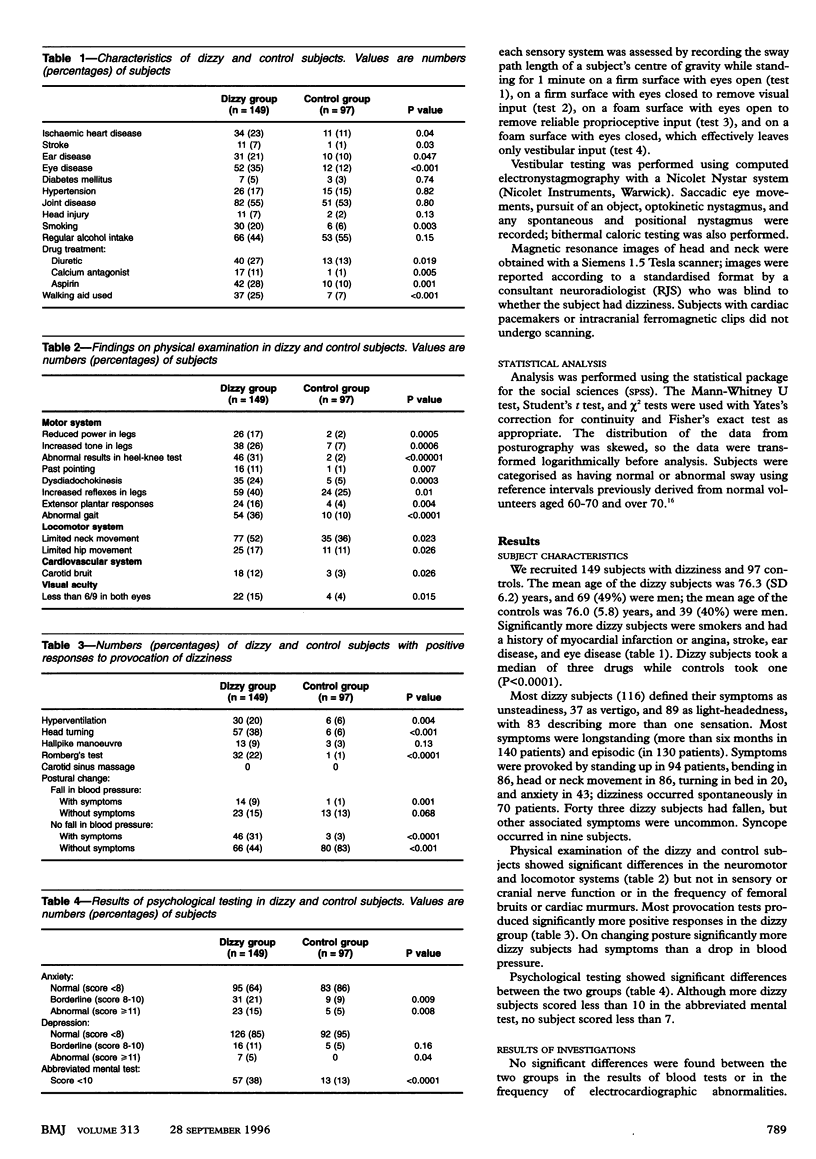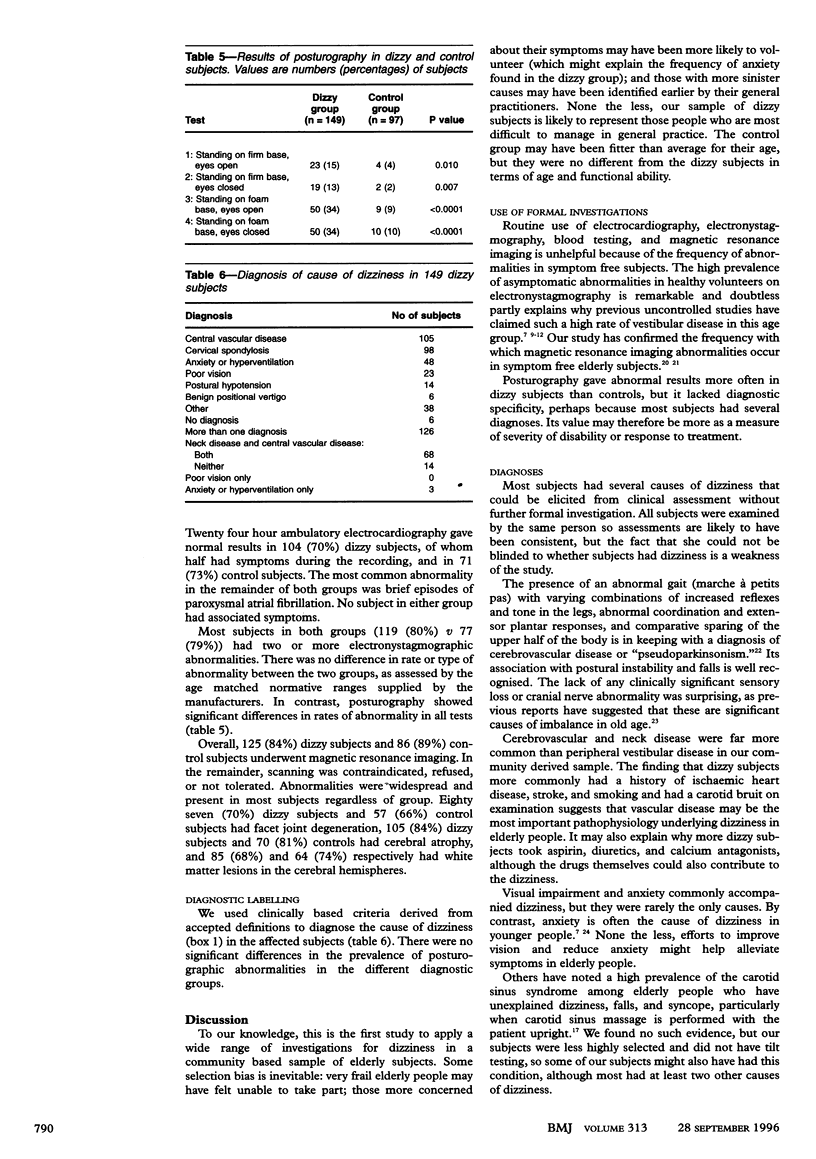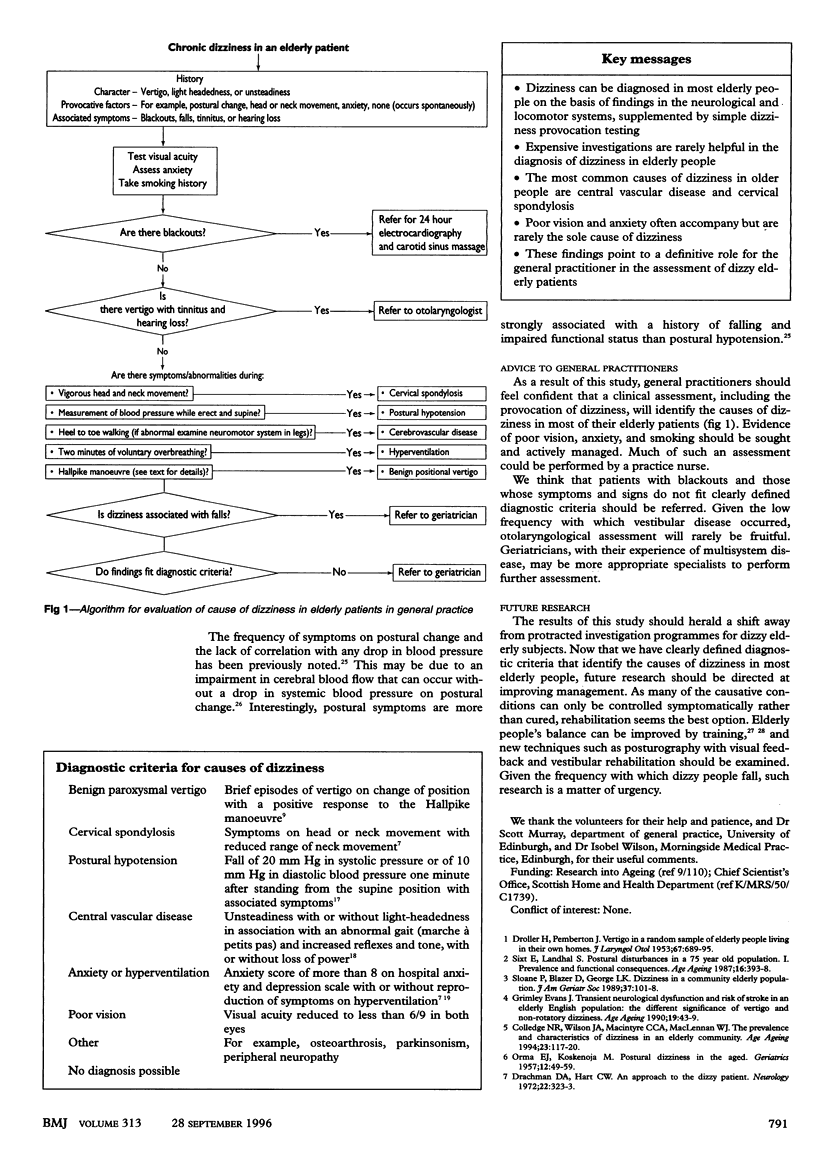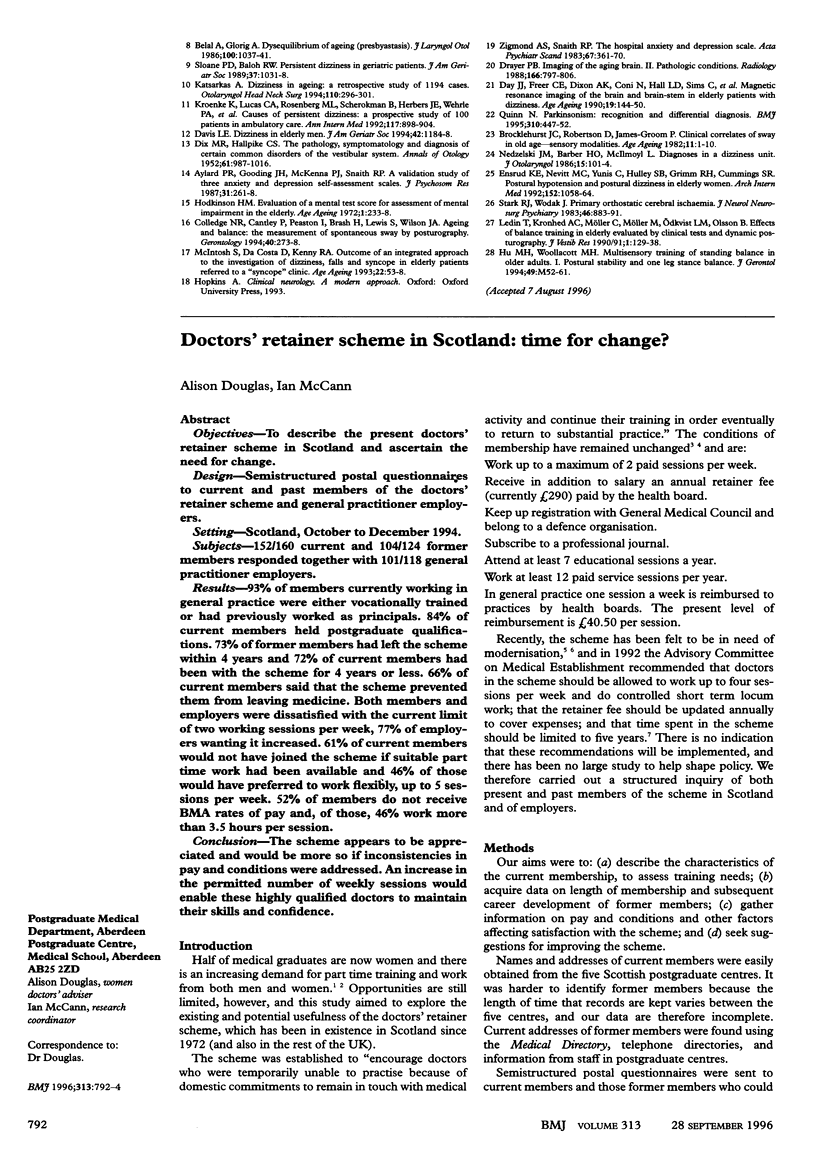Abstract
OBJECTIVE: To compare the findings in dizzy elderly people with those in controls of a similar age to identify which investigations differentiate dizzy from non-dizzy patients and to design an investigational algorithm. DESIGN: Community based study of clinical and laboratory findings in dizzy and control elderly people. SETTING: Research outpatient clinic at a teaching hospital. SUBJECTS: 149 dizzy and 97 control subjects aged over 65 years recruited from a community survey and articles in the local press. MAIN OUTCOME MEASURES: Findings on physical examination, blood testing, electrocardiography (at rest and over 24 hours), electronystagmography, posturography, and magnetic resonance imaging of head and neck (125 (84%) dizzy subjects and 86 (89%) controls); hospital anxiety and depression score; responses to hyperventilation, carotid sinus massage, and the Hallpike manoeuvre. RESULTS: Blood profile, electrocardiography, electronystagmography, and magnetic resonance imaging failed to distinguish dizzy from control subjects because of the frequency of asymptomatic abnormalities in controls. Posturography and clinical assessment (physical examination, dizziness provocation, and psychological assessment) showed significant differences between the groups. A cause of the dizziness was identified from clinical diagnostic criteria based on accepted definitions in 143 subjects, with 126 having more than one cause. The most common diagnoses were central vascular disease (105) and cervical spondylosis (98), often accompanied by poor vision and anxiety. CONCLUSION: Expensive investigations are rarely helpful in dizzy elderly people. The cause of the dizziness can be diagnosed in most cases on the basis of a thorough clinical examination without recourse to hospital referral.
Full text
PDF




Selected References
These references are in PubMed. This may not be the complete list of references from this article.
- Aylard P. R., Gooding J. H., McKenna P. J., Snaith R. P. A validation study of three anxiety and depression self-assessment scales. J Psychosom Res. 1987;31(2):261–268. doi: 10.1016/0022-3999(87)90083-3. [DOI] [PubMed] [Google Scholar]
- Belal A., Jr, Glorig A. Dysequilibrium of ageing (presbyastasis). J Laryngol Otol. 1986 Sep;100(9):1037–1041. doi: 10.1017/s0022215100100520. [DOI] [PubMed] [Google Scholar]
- Brocklehurst J. C., Robertson D., James-Groom P. Clinical correlates of sway in old age--sensory modalities. Age Ageing. 1982 Feb;11(1):1–10. doi: 10.1093/ageing/11.1.1. [DOI] [PubMed] [Google Scholar]
- Colledge N. R., Cantley P., Peaston I., Brash H., Lewis S., Wilson J. A. Ageing and balance: the measurement of spontaneous sway by posturography. Gerontology. 1994;40(5):273–278. doi: 10.1159/000213596. [DOI] [PubMed] [Google Scholar]
- DIX M. R., HALLPIKE C. S. The pathology, symptomatology and diagnosis of certain common disorders of the vestibular system. Ann Otol Rhinol Laryngol. 1952 Dec;61(4):987–1016. doi: 10.1177/000348945206100403. [DOI] [PubMed] [Google Scholar]
- DROLLER H., PEMBERTON J. Vertigo in a random sample of elderly people living in their homes. J Laryngol Otol. 1953 Nov;67(11):689–694. doi: 10.1017/s0022215100049185. [DOI] [PubMed] [Google Scholar]
- Davis L. E. Dizziness in elderly men. J Am Geriatr Soc. 1994 Nov;42(11):1184–1188. doi: 10.1111/j.1532-5415.1994.tb06986.x. [DOI] [PubMed] [Google Scholar]
- Day J. J., Freer C. E., Dixon A. K., Coni N., Hall L. D., Sims C., Gehlhaar E. W. Magnetic resonance imaging of the brain and brain-stem in elderly patients with dizziness. Age Ageing. 1990 Mar;19(2):144–150. doi: 10.1093/ageing/19.2.144. [DOI] [PubMed] [Google Scholar]
- Drachman D. A., Hart C. W. An approach to the dizzy patient. Neurology. 1972 Apr;22(4):323–334. doi: 10.1212/wnl.22.4.323. [DOI] [PubMed] [Google Scholar]
- Drayer B. P. Imaging of the aging brain. Part II. Pathologic conditions. Radiology. 1988 Mar;166(3):797–806. doi: 10.1148/radiology.166.3.3277248. [DOI] [PubMed] [Google Scholar]
- Ensrud K. E., Nevitt M. C., Yunis C., Hulley S. B., Grimm R. H., Cummings S. R. Postural hypotension and postural dizziness in elderly women. The study of osteoporotic fractures. The Study of Osteoporotic Fractures Research Group. Arch Intern Med. 1992 May;152(5):1058–1064. [PubMed] [Google Scholar]
- Evans J. G. Transient neurological dysfunction and risk of stroke in an elderly English population: the different significance of vertigo and non-rotatory dizziness. Age Ageing. 1990 Jan;19(1):43–49. doi: 10.1093/ageing/19.1.43. [DOI] [PubMed] [Google Scholar]
- Hodkinson H. M. Evaluation of a mental test score for assessment of mental impairment in the elderly. Age Ageing. 1972 Nov;1(4):233–238. doi: 10.1093/ageing/1.4.233. [DOI] [PubMed] [Google Scholar]
- Hu M. H., Woollacott M. H. Multisensory training of standing balance in older adults: I. Postural stability and one-leg stance balance. J Gerontol. 1994 Mar;49(2):M52–M61. doi: 10.1093/geronj/49.2.m52. [DOI] [PubMed] [Google Scholar]
- Katsarkas A. Dizziness in aging: a retrospective study of 1194 cases. Otolaryngol Head Neck Surg. 1994 Mar;110(3):296–301. doi: 10.1177/019459989411000306. [DOI] [PubMed] [Google Scholar]
- Kroenke K., Lucas C. A., Rosenberg M. L., Scherokman B., Herbers J. E., Jr, Wehrle P. A., Boggi J. O. Causes of persistent dizziness. A prospective study of 100 patients in ambulatory care. Ann Intern Med. 1992 Dec 1;117(11):898–904. doi: 10.7326/0003-4819-117-11-898. [DOI] [PubMed] [Google Scholar]
- Ledin T., Kronhed A. C., Möller C., Möller M., Odkvist L. M., Olsson B. Effects of balance training in elderly evaluated by clinical tests and dynamic posturography. J Vestib Res. 1990 1991;1(2):129–138. [PubMed] [Google Scholar]
- McIntosh S., Da Costa D., Kenny R. A. Outcome of an integrated approach to the investigation of dizziness, falls and syncope in elderly patients referred to a 'syncope' clinic. Age Ageing. 1993 Jan;22(1):53–58. doi: 10.1093/ageing/22.1.53. [DOI] [PubMed] [Google Scholar]
- Nedzelski J. M., Barber H. O., McIlmoyl L. Diagnoses in a dizziness unit. J Otolaryngol. 1986 Apr;15(2):101–104. [PubMed] [Google Scholar]
- Quinn N. Parkinsonism--recognition and differential diagnosis. BMJ. 1995 Feb 18;310(6977):447–452. doi: 10.1136/bmj.310.6977.447. [DOI] [PMC free article] [PubMed] [Google Scholar]
- Sixt E., Landahl S. Postural disturbances in a 75-year-old population: I. Prevalence and functional consequences. Age Ageing. 1987 Nov;16(6):393–398. doi: 10.1093/ageing/16.6.393. [DOI] [PubMed] [Google Scholar]
- Sloane P. D., Baloh R. W. Persistent dizziness in geriatric patients. J Am Geriatr Soc. 1989 Nov;37(11):1031–1038. doi: 10.1111/j.1532-5415.1989.tb06916.x. [DOI] [PubMed] [Google Scholar]
- Sloane P., Blazer D., George L. K. Dizziness in a community elderly population. J Am Geriatr Soc. 1989 Feb;37(2):101–108. doi: 10.1111/j.1532-5415.1989.tb05867.x. [DOI] [PubMed] [Google Scholar]
- Stark R. J., Wodak J. Primary orthostatic cerebral ischaemia. J Neurol Neurosurg Psychiatry. 1983 Oct;46(10):883–891. doi: 10.1136/jnnp.46.10.883. [DOI] [PMC free article] [PubMed] [Google Scholar]
- Zigmond A. S., Snaith R. P. The hospital anxiety and depression scale. Acta Psychiatr Scand. 1983 Jun;67(6):361–370. doi: 10.1111/j.1600-0447.1983.tb09716.x. [DOI] [PubMed] [Google Scholar]


